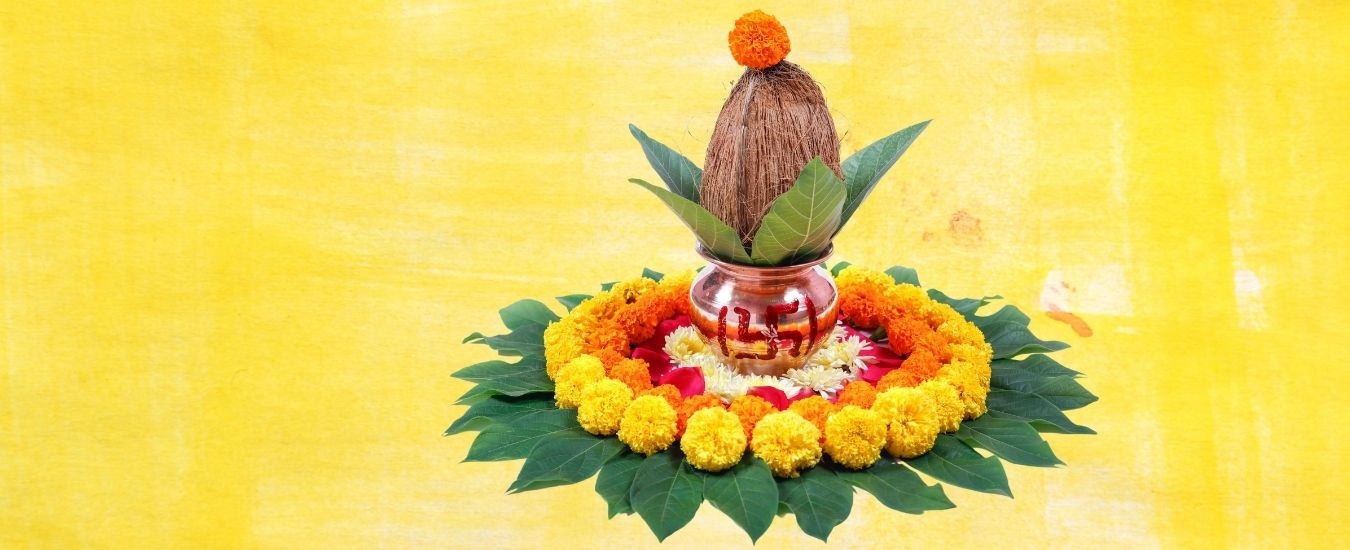Ever noticed a shiny pot with mango leaves and a coconut perched on top at Indian ceremonies and wondered what it signifies? That’s the Mangal Kalash, a revered item in Sanatan Dharma, steeped in rituals and spiritual meanings. More than a decorative object, it’s a spiritual conduit symbolizing prosperity, fertility, and the presence of divine cosmic energy.
The Mangal Kalash is more than a ritual object – it’s a spiritual embodiment of cosmic order, ancestral wisdom, and auspicious beginnings. Whether at a grand wedding or a simple housewarming, its presence is a reminder of India’s deep-rooted ritual intelligence and timeless traditions.
Cultural and Spiritual Symbolism of the Mangal Kalash
A Vessel of the Divine
Derived from Sanskrit, “Kalash” means “pitcher” or “vessel.” When transformed into a Mangal Kalash, it becomes a sacred container for invoking deities like Goddess Lakshmi and Lord Vishnu, especially during shubh muhurat.
Representation in Vedic Cosmology
The Kalash is a microcosmic representation of the universe, encompassing the Pancha Mahabhutas – Earth, Water, Fire, Air, and Ether. It features prominently in yajnas, Vastu Shanti puja, and samskara rituals.
Components of a Mangal Kalash
- Kalash Pot: Traditionally made from copper, brass, or silver, each material holds spiritual significance. Copper is said to conduct energy, while silver represents purity.
- Water: Usually filled with Ganga Jal or holy water, symbolizing pranic energy. Nine grains (navadhanya) or coins may be added to represent Navagrahas.
- Mango Leaves: Arranged in a circular pattern to signify the five senses, Pancha indriya, and universal balance.
- Coconut: Smeared with turmeric, kumkum, and sandalwood paste, it represents the womb of creation, also seen as the third eye of Shiva.
- Red Cloth and Mauli (sacred thread): Tied around the pot, this enhances ritual purity and auspiciousness.
Ritual Science and Symbolism
The Mangal Kalash operates like a spiritual antenna, capturing and radiating positive vibrations. The Vedic mantras, when chanted, energize the Kalash, storing the spiritual charge like a divine battery.
When Is the Mangal Kalash Used?
- Graha Shanti Puja: To calm planetary influences.
- Mandap Setup: Symbolizes a purified space for sacred vows.
- Kalasha Sthapana Ceremony: Marks the beginning of rituals with Sankalp.
- Griha Pravesh (Housewarming): Welcomes abundance into the new home.
- Festivals: Especially prominent during Navratri, Diwali, and Vastu Puja.
Cultural Variations in Kalash Usage
- North India: Painted with swastika or OM, tied with Mauli, used in Simant Puja.
- South India: Decorated with banana leaves, sandalwood, and shloka chanting.
- Maharashtra: Involves turmeric, rice, and sacred symbols during Haldi.
- Bengal: The Ganga Nimantran ritual invokes river blessings into the Kalash.
Step-by-Step Guide to Set Up a Mangal Kalash
- Select a polished copper or brass vessel cleaned with holy water.
- Fill it with Ganga Jal, and add a coin or betel nut.
- Arrange five mango leaves in a flower-like pattern.
- Place the coconut wrapped in a red cloth, smeared with kumkum and sandalwood paste.
- Tie a sacred thread (Mauli) around the neck of the pot.
- Light a diya and recite the Kalasha Sthapana mantra with a Brahmin priest leading the Sankalp.
Dos and Don’ts
- Always place in the northeast (Ishan) corner, as per Vastu principles.
- Don’t reuse unclean items or place the Kalash directly on the floor.
- Use a ritual pedestal (ashtamangala or chowki) for placement.
Beyond Weddings – Mangal Kalash in Modern Rituals
- Used during Upanayan Sanskar, naming ceremonies, and eco-conscious pujas.
- Eco-friendly Kalash made of clay or recyclable materials are encouraged in sustainable celebrations.
Modern Aesthetics and Decor
- Integrate Kalash into wedding centrepieces, photo booths, or even wedding favours.
- Use decorative beads, rangoli, and flower garlands to create a modern-vintage spiritual fusion.
Emotional and Generational Value
- Passed on as family heirlooms, symbolizing ancestral blessings, cultural continuity, and devotional lineage.
FAQs
What does a Mangal Kalash symbolize?
It symbolizes prosperity, purity, and the presence of divine energy during auspicious ceremonies.
Can I use any metal for the Kalash?
Preferably use copper, brass, or silver for traditional and energetic purposes. Avoid plastic or steel for rituals.
Is it necessary to use mango leaves only?
Mango leaves are traditional, but in their absence, betel or neem leaves can be used depending on regional customs.
Can the same Kalash be reused for other ceremonies?
Yes, if it is properly cleansed and maintained with respect, it can be reused for different pujas.
How do I dispose of the Kalash after the wedding?
Offer the contents (like water and coconut) to a tree or river respectfully. The pot can be kept for future use or respectfully immersed if it’s no longer usable.
